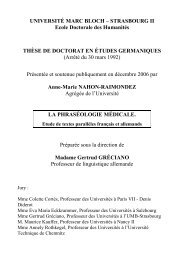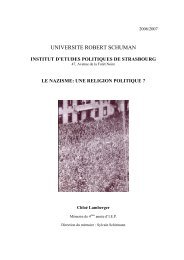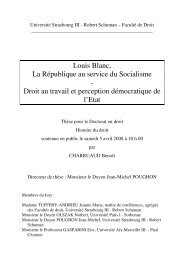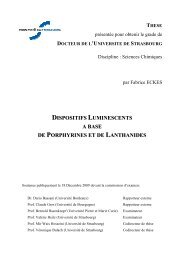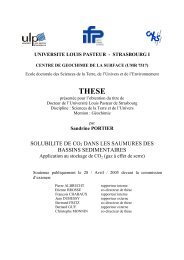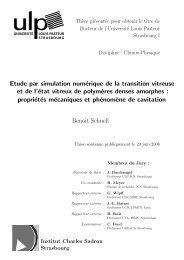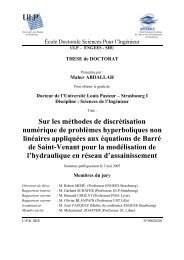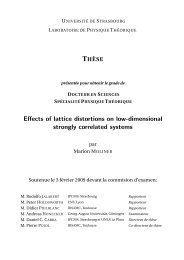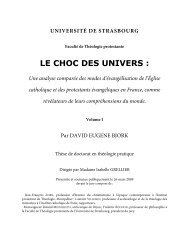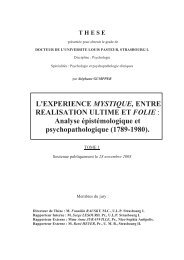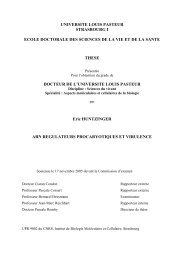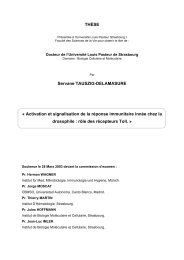Anthony KERMAGORET - THESES ET MEMOIRES DE L'UDS
Anthony KERMAGORET - THESES ET MEMOIRES DE L'UDS
Anthony KERMAGORET - THESES ET MEMOIRES DE L'UDS
Create successful ePaper yourself
Turn your PDF publications into a flip-book with our unique Google optimized e-Paper software.
5. Experimental Section<br />
Chapitre IV<br />
General Considerations. All solvents were dried and freshly distilled under nitrogen<br />
prior to use using common techniques. All manipulations were carried out using Schlenk<br />
techniques. The 1 H, 31 P{ 1 H} and 13 C{ 1 H} NMR spectra were recorded at 300.13, 121.5 and<br />
76 MHz, respectively, on a Bruker AC300 instrument. Elemental analyses were performed<br />
by the “Service de Microanalyse, Université Louis Pasteur (Strasbourg, France)”. IR spectra<br />
in the range of 4000-400 cm -1 were recorded on a Bruker IFS28FT. Mass spectra were<br />
recorded with a Bruker Daltonics microTOF (ESI; positive mode; capillary voltage: 4.8 kV;<br />
nebulizer pressure: 0.2 bar; desolvation temperature: 180 °C; desolvation gas flow rate: 4.5<br />
L/min). Magnetic moments were determined by the Evans method in CD2Cl2 using a solution<br />
of CH3NO2 in CD2Cl2 (20:80, v/v) as reference. 61-64 The complexes NiCl2⋅6H2O and<br />
NiBr2⋅6H2O were dried by heating at 160 °C overnight under vacuum to give anhydrous<br />
NiCl2 and NiBr2. The commercial compounds 2-picoline and (pyridin-2-yl)methanol were<br />
distilled at 130 °C and 115 °C, respectively, and degassed with nitrogen before use. A<br />
solution of NaPPh2 was prepared according to the literature, 75 by addition of PPh2Cl (7.40 g,<br />
6 mL, 33.4 mmol) to a suspension of Na (4.00 g, 174.0 mmol) in THF (100 mL). After the<br />
mixture was stirred at reflux for 4 h, the solution became red and a grey precipitate of NaCl<br />
appeared. The salt and unreacted Na were eliminated by filtration through a canula and the<br />
compound was kept in THF. Gas chromatographic analyses were performed on a<br />
Thermoquest GC8000 Top series gas chromatograph using a HP Pona column (50 m, 0.2<br />
mm diameter, 0.5 µm film thickness). Details of the synthesis and analytical data for known<br />
compounds are given below because of slight modifications or new data introduced.<br />
2-[(trimethylsilyl)methyl]pyridine. 76<br />
A solution of n-BuLi (96.0 mmol, 1.6 M in hexane) was added dropwise over 15<br />
minutes to a solution of 2-picoline (8.94 g, 96.0 mmol) in 100 mL of THF at -78 °C. After<br />
complete deprotonation, the red anion precipitated and after further stirring for 1 h at -78 °C,<br />
degassed chlorotrimethylsilane (TMSCl, 14.00 g, 112.0 mmol) was added dropwise to the<br />
solution. The brown mixture was allowed to reach at room temperature overnight and the<br />
solvents and unreacted TMSCl were evaporated under reduced pressure. The residue was<br />
distilled (120 °C, 12 mbar) to afford pure, liquid 2-[(trimethylsilyl)methyl]pyridine. Yield:<br />
6.61 g, 42%. 1 H NMR (CDCl3): δ 0.00 (s, 9H, Si(CH3)], 2.32 (s, 2H, SiCH2), 6.93 (m, 2H,<br />
Py), 7.45 (m, Py), 8.39 (d, 1H, 3 JH-H = 4.2 Hz, HCN). 13 C{ 1 H} NMR (CDCl3): δ -1.7 (s,<br />
23



